Yawei Luo
Part-X-MLLM: Part-aware 3D Multimodal Large Language Model
Nov 17, 2025Abstract:We introduce Part-X-MLLM, a native 3D multimodal large language model that unifies diverse 3D tasks by formulating them as programs in a structured, executable grammar. Given an RGB point cloud and a natural language prompt, our model autoregressively generates a single, coherent token sequence encoding part-level bounding boxes, semantic descriptions, and edit commands. This structured output serves as a versatile interface to drive downstream geometry-aware modules for part-based generation and editing. By decoupling the symbolic planning from the geometric synthesis, our approach allows any compatible geometry engine to be controlled through a single, language-native frontend. We pre-train a dual-encoder architecture to disentangle structure from semantics and instruction-tune the model on a large-scale, part-centric dataset. Experiments demonstrate that our model excels at producing high-quality, structured plans, enabling state-of-the-art performance in grounded Q\&A, compositional generation, and localized editing through one unified interface. Project page: https://chunshi.wang/Part-X-MLLM/
TinySR: Pruning Diffusion for Real-World Image Super-Resolution
Aug 24, 2025

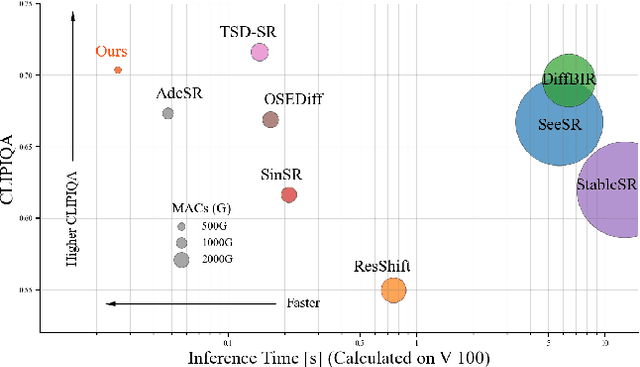
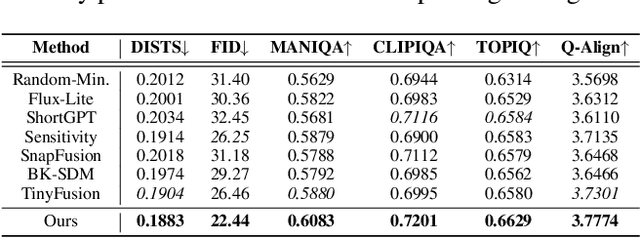
Abstract:Real-world image super-resolution (Real-ISR) focuses on recovering high-quality images from low-resolution inputs that suffer from complex degradations like noise, blur, and compression. Recently, diffusion models (DMs) have shown great potential in this area by leveraging strong generative priors to restore fine details. However, their iterative denoising process incurs high computational overhead, posing challenges for real-time applications. Although one-step distillation methods, such as OSEDiff and TSD-SR, offer faster inference, they remain fundamentally constrained by their large, over-parameterized model architectures. In this work, we present TinySR, a compact yet effective diffusion model specifically designed for Real-ISR that achieves real-time performance while maintaining perceptual quality. We introduce a Dynamic Inter-block Activation and an Expansion-Corrosion Strategy to facilitate more effective decision-making in depth pruning. We achieve VAE compression through channel pruning, attention removal and lightweight SepConv. We eliminate time- and prompt-related modules and perform pre-caching techniques to further speed up the model. TinySR significantly reduces computational cost and model size, achieving up to 5.68x speedup and 83% parameter reduction compared to its teacher TSD-SR, while still providing high quality results.
ParticleGS: Particle-Based Dynamics Modeling of 3D Gaussians for Prior-free Motion Extrapolation
May 26, 2025Abstract:This paper aims to model the dynamics of 3D Gaussians from visual observations to support temporal extrapolation. Existing dynamic 3D reconstruction methods often struggle to effectively learn underlying dynamics or rely heavily on manually defined physical priors, which limits their extrapolation capabilities. To address this issue, we propose a novel dynamic 3D Gaussian Splatting prior-free motion extrapolation framework based on particle dynamics systems. The core advantage of our method lies in its ability to learn differential equations that describe the dynamics of 3D Gaussians, and follow them during future frame extrapolation. Instead of simply fitting to the observed visual frame sequence, we aim to more effectively model the gaussian particle dynamics system. To this end, we introduce a dynamics latent state vector into the standard Gaussian kernel and design a dynamics latent space encoder to extract initial state. Subsequently, we introduce a Neural ODEs-based dynamics module that models the temporal evolution of Gaussian in dynamics latent space. Finally, a Gaussian kernel space decoder is used to decode latent state at the specific time step into the deformation. Experimental results demonstrate that the proposed method achieves comparable rendering quality with existing approaches in reconstruction tasks, and significantly outperforms them in future frame extrapolation. Our code is available at https://github.com/QuanJinSheng/ParticleGS.
MASTER: Multi-Agent Security Through Exploration of Roles and Topological Structures -- A Comprehensive Framework
May 24, 2025Abstract:Large Language Models (LLMs)-based Multi-Agent Systems (MAS) exhibit remarkable problem-solving and task planning capabilities across diverse domains due to their specialized agentic roles and collaborative interactions. However, this also amplifies the severity of security risks under MAS attacks. To address this, we introduce MASTER, a novel security research framework for MAS, focusing on diverse Role configurations and Topological structures across various scenarios. MASTER offers an automated construction process for different MAS setups and an information-flow-based interaction paradigm. To tackle MAS security challenges in varied scenarios, we design a scenario-adaptive, extensible attack strategy utilizing role and topological information, which dynamically allocates targeted, domain-specific attack tasks for collaborative agent execution. Our experiments demonstrate that such an attack, leveraging role and topological information, exhibits significant destructive potential across most models. Additionally, we propose corresponding defense strategies, substantially enhancing MAS resilience across diverse scenarios. We anticipate that our framework and findings will provide valuable insights for future research into MAS security challenges.
MAGIC: Motion-Aware Generative Inference via Confidence-Guided LLM
May 22, 2025Abstract:Recent advances in static 3D generation have intensified the demand for physically consistent dynamic 3D content. However, existing video generation models, including diffusion-based methods, often prioritize visual realism while neglecting physical plausibility, resulting in implausible object dynamics. Prior approaches for physics-aware dynamic generation typically rely on large-scale annotated datasets or extensive model fine-tuning, which imposes significant computational and data collection burdens and limits scalability across scenarios. To address these challenges, we present MAGIC, a training-free framework for single-image physical property inference and dynamic generation, integrating pretrained image-to-video diffusion models with iterative LLM-based reasoning. Our framework generates motion-rich videos from a static image and closes the visual-to-physical gap through a confidence-driven LLM feedback loop that adaptively steers the diffusion model toward physics-relevant motion. To translate visual dynamics into controllable physical behavior, we further introduce a differentiable MPM simulator operating directly on 3D Gaussians reconstructed from the single image, enabling physically grounded, simulation-ready outputs without any supervision or model tuning. Experiments show that MAGIC outperforms existing physics-aware generative methods in inference accuracy and achieves greater temporal coherence than state-of-the-art video diffusion models.
DecoupledESC: Enhancing Emotional Support Generation via Strategy-Response Decoupled Preference Optimization
May 22, 2025Abstract:Recent advances in Emotional Support Conversation (ESC) have improved emotional support generation by fine-tuning Large Language Models (LLMs) via Supervised Fine-Tuning (SFT). However, common psychological errors still persist. While Direct Preference Optimization (DPO) shows promise in reducing such errors through pairwise preference learning, its effectiveness in ESC tasks is limited by two key challenges: (1) Entangled data structure: Existing ESC data inherently entangles psychological strategies and response content, making it difficult to construct high-quality preference pairs; and (2) Optimization ambiguity: Applying vanilla DPO to such entangled pairwise data leads to ambiguous training objectives. To address these issues, we introduce Inferential Preference Mining (IPM) to construct high-quality preference data, forming the IPM-PrefDial dataset. Building upon this data, we propose a Decoupled ESC framework inspired by Gross's Extended Process Model of Emotion Regulation, which decomposes the ESC task into two sequential subtasks: strategy planning and empathic response generation. Each was trained via SFT and subsequently enhanced by DPO to align with the psychological preference. Extensive experiments demonstrate that our Decoupled ESC framework outperforms joint optimization baselines, reducing preference bias and improving response quality.
SF2T: Self-supervised Fragment Finetuning of Video-LLMs for Fine-Grained Understanding
Apr 10, 2025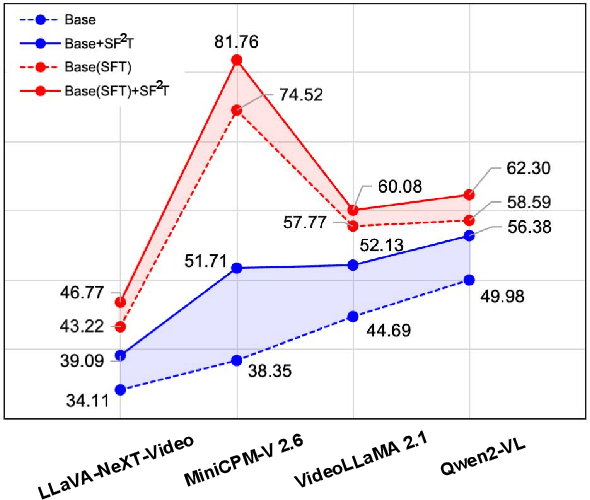



Abstract:Video-based Large Language Models (Video-LLMs) have witnessed substantial advancements in recent years, propelled by the advancement in multi-modal LLMs. Although these models have demonstrated proficiency in providing the overall description of videos, they struggle with fine-grained understanding, particularly in aspects such as visual dynamics and video details inquiries. To tackle these shortcomings, we find that fine-tuning Video-LLMs on self-supervised fragment tasks, greatly improve their fine-grained video understanding abilities. Hence we propose two key contributions:(1) Self-Supervised Fragment Fine-Tuning (SF$^2$T), a novel effortless fine-tuning method, employs the rich inherent characteristics of videos for training, while unlocking more fine-grained understanding ability of Video-LLMs. Moreover, it relieves researchers from labor-intensive annotations and smartly circumvents the limitations of natural language, which often fails to capture the complex spatiotemporal variations in videos; (2) A novel benchmark dataset, namely FineVidBench, for rigorously assessing Video-LLMs' performance at both the scene and fragment levels, offering a comprehensive evaluation of their capabilities. We assessed multiple models and validated the effectiveness of SF$^2$T on them. Experimental results reveal that our approach improves their ability to capture and interpret spatiotemporal details.
EduPlanner: LLM-Based Multi-Agent Systems for Customized and Intelligent Instructional Design
Apr 07, 2025Abstract:Large Language Models (LLMs) have significantly advanced smart education in the Artificial General Intelligence (AGI) era. A promising application lies in the automatic generalization of instructional design for curriculum and learning activities, focusing on two key aspects: (1) Customized Generation: generating niche-targeted teaching content based on students' varying learning abilities and states, and (2) Intelligent Optimization: iteratively optimizing content based on feedback from learning effectiveness or test scores. Currently, a single large LLM cannot effectively manage the entire process, posing a challenge for designing intelligent teaching plans. To address these issues, we developed EduPlanner, an LLM-based multi-agent system comprising an evaluator agent, an optimizer agent, and a question analyst, working in adversarial collaboration to generate customized and intelligent instructional design for curriculum and learning activities. Taking mathematics lessons as our example, EduPlanner employs a novel Skill-Tree structure to accurately model the background mathematics knowledge of student groups, personalizing instructional design for curriculum and learning activities according to students' knowledge levels and learning abilities. Additionally, we introduce the CIDDP, an LLM-based five-dimensional evaluation module encompassing clarity, Integrity, Depth, Practicality, and Pertinence, to comprehensively assess mathematics lesson plan quality and bootstrap intelligent optimization. Experiments conducted on the GSM8K and Algebra datasets demonstrate that EduPlanner excels in evaluating and optimizing instructional design for curriculum and learning activities. Ablation studies further validate the significance and effectiveness of each component within the framework. Our code is publicly available at https://github.com/Zc0812/Edu_Planner
Advances in 4D Generation: A Survey
Mar 19, 2025Abstract:Generative artificial intelligence (AI) has made significant progress across various domains in recent years. Building on the rapid advancements in 2D, video, and 3D content generation fields, 4D generation has emerged as a novel and rapidly evolving research area, attracting growing attention. 4D generation focuses on creating dynamic 3D assets with spatiotemporal consistency based on user input, offering greater creative freedom and richer immersive experiences. This paper presents a comprehensive survey of the 4D generation field, systematically summarizing its core technologies, developmental trajectory, key challenges, and practical applications, while also exploring potential future research directions. The survey begins by introducing various fundamental 4D representation models, followed by a review of 4D generation frameworks built upon these representations and the key technologies that incorporate motion and geometry priors into 4D assets. We summarize five major challenges of 4D generation: consistency, controllability, diversity, efficiency, and fidelity, accompanied by an outline of existing solutions to address these issues. We systematically analyze applications of 4D generation, spanning dynamic object generation, scene generation, digital human synthesis, 4D editing, and autonomous driving. Finally, we provide an in-depth discussion of the obstacles currently hindering the development of the 4D generation. This survey offers a clear and comprehensive overview of 4D generation, aiming to stimulate further exploration and innovation in this rapidly evolving field. Our code is publicly available at: https://github.com/MiaoQiaowei/Awesome-4D.
Grounding Creativity in Physics: A Brief Survey of Physical Priors in AIGC
Feb 10, 2025
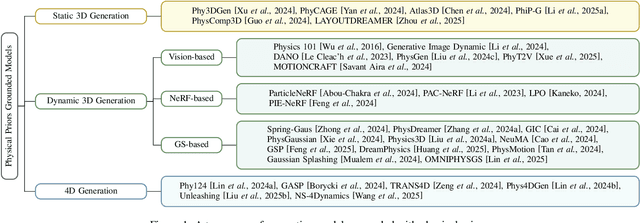

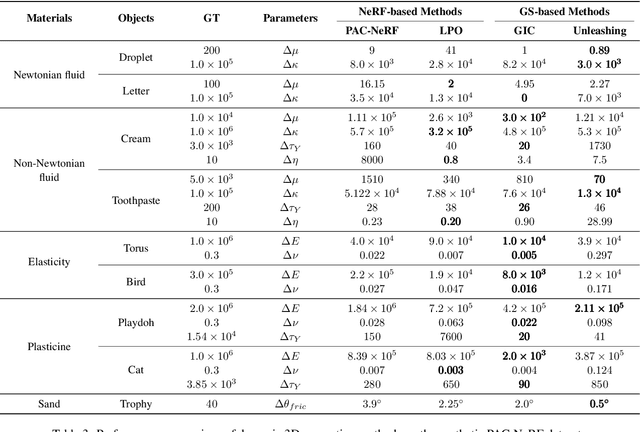
Abstract:Recent advancements in AI-generated content have significantly improved the realism of 3D and 4D generation. However, most existing methods prioritize appearance consistency while neglecting underlying physical principles, leading to artifacts such as unrealistic deformations, unstable dynamics, and implausible objects interactions. Incorporating physics priors into generative models has become a crucial research direction to enhance structural integrity and motion realism. This survey provides a review of physics-aware generative methods, systematically analyzing how physical constraints are integrated into 3D and 4D generation. First, we examine recent works in incorporating physical priors into static and dynamic 3D generation, categorizing methods based on representation types, including vision-based, NeRF-based, and Gaussian Splatting-based approaches. Second, we explore emerging techniques in 4D generation, focusing on methods that model temporal dynamics with physical simulations. Finally, we conduct a comparative analysis of major methods, highlighting their strengths, limitations, and suitability for different materials and motion dynamics. By presenting an in-depth analysis of physics-grounded AIGC, this survey aims to bridge the gap between generative models and physical realism, providing insights that inspire future research in physically consistent content generation.
 Add to Chrome
Add to Chrome Add to Firefox
Add to Firefox Add to Edge
Add to Edge